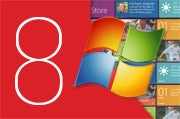
Windows 8 should make using your peripherals easier and more efficient, especially if you use a USB 3.0 device or a dongle-style modem to connect to a mobile broadband network.
The OS will include native drivers for classes of devices that haven't previously had them, and it will also change how drivers look and behave in the new Metro-style interface you may be familiar with from Windows Phone 7 handsets.
Microsoft has always had built-in device drivers, and their advantage is two-fold.
First, it makes dealing with a new peripheral much easier. If you remember the dawn of USB thumb drives, you probably remember having to install a separate driver for each thumb drive you used. Once Microsoft included native drivers, that hassle was over. Built-in class drivers also (often) provide better performance.
When a technology is new--for example, mobile broadband dongles and USB 3.0--Microsoft usually lags behind before integrating that technology into its operating system. But now mobile broadband and USB 3.0 have been brought into the fold.
Mobile Broadband
 If you use a USB dongle to connect to the Web, you'll no longer need to deal with proprietary, annoying-to-install drivers masquerading as connection managers. Even the controls for turning the wireless radio on and off will be included in the OS. Reconnecting to your mobile network after you've been dropped should also be significantly smoother, and Windows will now be able to detect your account's network usage and block or warn you when you reach your limit.
If you use a USB dongle to connect to the Web, you'll no longer need to deal with proprietary, annoying-to-install drivers masquerading as connection managers. Even the controls for turning the wireless radio on and off will be included in the OS. Reconnecting to your mobile network after you've been dropped should also be significantly smoother, and Windows will now be able to detect your account's network usage and block or warn you when you reach your limit.USB 3.0 Support
Built-in support for USB 3.0 means USB 3.0 devices connected to a Windows 8 machine should have better performance than current third-party drivers can provide. It also means that Windows will finally be able to take full advantage of the USB 3.0 spec, giving the system the ability to, for example, spin down external hard drives and save power when they're not being used.
 Jeff Ravencraft, president of the USB Implementers Forum (the industry group that oversees the USB 3.0 specification), notes that it's not that current USB 3.0 drivers haven't been able to exert the same control, but that by having the class driver integrated into the operating system, the devices will perform more efficiently.
Jeff Ravencraft, president of the USB Implementers Forum (the industry group that oversees the USB 3.0 specification), notes that it's not that current USB 3.0 drivers haven't been able to exert the same control, but that by having the class driver integrated into the operating system, the devices will perform more efficiently.Windows 8 demos at Microsoft's BUILD conference did show USB 3.0 transfers that were far faster than USB 2.0 transfers. However, the demos did not compare the performance with that of USB 3.0 devices running on Windows 7 with a third-party driver.
Windows 8 will also include class drivers for other devices, such as printers, sensors, touch-input devices, and displays. A new human-interface device driver will support sensors for heat, light, temperature, pressure, current, and motion, according to Microsoft. This driver could support sensors beyond the norm, too, such as a blood-pressure monitor or a device that can sense when a glass is broken.
Pretty-Looking Drivers?
Much of Microsoft's pitch for Windows 8 has centered on its new visual style, called Metro, which is also used in Windows Phone 7 phones. That new design will even extend into device drivers. Gone are the drab gray and clunky dialog boxes of yesteryear. App drivers can now become part of the settings "charm," an icon in the right Windows 8 navigation panel.
Windows-certified devices, such as cameras, TVs, or printers, will launch the appropriate Metro-style app within the charms to allow sharing of data or other actions. This approach makes the driver feel like it's integrated into the Metro experience and will reportedly change how companies distribute, and how you update, drivers.
If, though, you opt to use the desktop interface and desktop apps, nothing has changed--the dialog boxes remain in all their primitive glory.








0 التعليقات:
Post a Comment